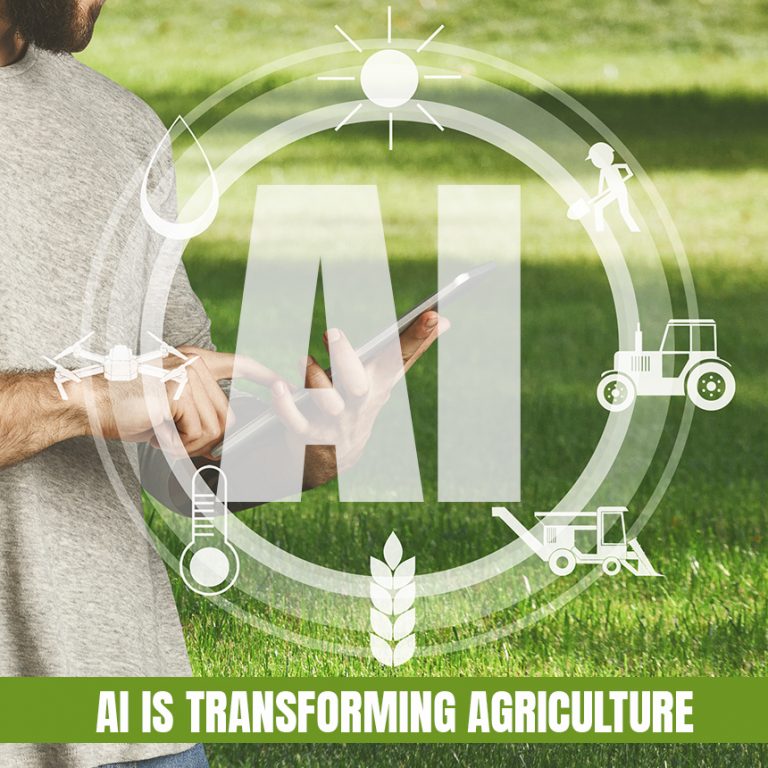
Agriculture or farming is one of the oldest and essential professions in the world. The way humans farm and grow crops has changed drastically over the millennia with the debut of diverse technologies. With the population of the world continually growing and land becoming scarcer, the onus is on the farmers and agriculturists to get more creative and efficient in producing more quality crops using less area.
Despite agriculture being a $5 trillion global industry, the sector is struggling to manage threats to insulate crops against pests, climate change, monocropping, and prevalent pesticide use. These were the reasons for agriculturists to adopt Artificial Intelligence (AI) in agriculture. AI in agriculture can be primarily attributed to climate change, population growth, and food security concerns.
The industry now strives to yield healthier crops, monitor soil and growing conditions, control pests, organize data for farmers, assist with the workload, and boost a diverse range of agri-related tasks in the entire food supply chain with the help of AI. Artificial Intelligence is now being utilized in agriculture in various ways.
Related: All you need to know about Artificial Intelligence – Beginners Guide Part 1
AI to Analyze Farm Data:
Farms generate hundreds of thousands of data points every day. With the help of AI, farmers are now in a position to interpret a variety of things in real-time. Precision agriculture intelligence platforms have been roped in to assess weather conditions, temperature, water usage, or soil conditions obtained from far to enlighten farmers’ decisions better. Agriculturists use AI-driven technologies to assist them in optimizing planning to create abundance yields by determining crop choices, the best hybrid seed options, and resource utilization.
Improve Harvest Quality and Accuracy:
With precision agriculture technology, artificial intelligence systems are improving harvest quality and efficiency. Using precision agriculture, farmers can detect diseases in plants, pests, and reduced plant nutrition in farms. The artificial intelligence sensors detect and earmarks weeds and then decide which herbicides to apply. This method helps to prevent over-application of herbicides and excessive toxins that find its way in our food.
Seasonal Forecasting:
Agricultural accuracy and an increase in productivity get a boost with farmers using AI to create seasonal forecasting models. Specific AI-powered tools can predict impending weather patterns months to aid farmers in their decisions. Seasonal forecasting is particularly beneficial for small farms in developing countries as there usually a dearth of data and knowledge. Over 70 % of the world’s crops come from small farms, and it becomes more prudent to keep these small farms operational for a bountiful yield with the help of AI.
Agriculture Drones:
Apart from data from the ground, farmers are also looking skyward to monitor the farm. Computer vision, deep learning algorithms coupled with machine learning process data captured from drones flying over farmers’ farms. Drones with AI-enabled cameras can capture images of entire farm tracts and analyze the images in real-time. This helps in identifying problem areas and room for potential improvements. Drones in the sky can obviously out best humans on foot, allowing large farms to be monitored more frequently.
AI Takes On Labor Challenge:
People entering the farming profession has dwindled annually since the industrial revolution. Hence, Farms, world-over are facing a workforce shortage. Most of the farms have needed a large number of workers, mostly seasonal, to harvest crops and keep farms productive. To counter this problem of workforce shortage in farms, agriculturists have now turned towards AI agriculture bots. These bots can harvest crops at a faster pace and in higher volumes than human laborers, while accurately identifying and eliminating weeds. Bots can reduce costs for farms by having a 24/7 workforce.
Chatbots In Agriculture:
Chatbots are used excessively in agriculture for assistance. Chatbots are capable of answering a plethora of queries, provide advice, and recommendations on specific farm problems.
Indoor Farming:
Thanks to tech-induced agriculture, farmers are ambitious and are taking up indoor agriculture. A technique of growing crops or plants on a large scale in a packed and controlled environment is gaining currency these days. Plant growing methods such as hydroponics and leveraging artificial lights to give the nutrients and light levels required for plants’ growth is in fashion too. AI-enabled indoor farming is inducing a whole new crop of farmers now. AI-driven technologies track every step of the indoor plant growing process.
In conclusion, AI in agriculture is letting farmers worldwide to function more efficiently, enabling farms of all sizes to operate and work while keeping the world fed. The ONPASSIVE ecosystem, with its futuristic AI-enabled business solution, has specific tools that could be implemented in agriculture as well.
The future of farming depends mostly on the adoption of AI and cognitive solutions. Large scale research is a continual process, and some applications are readily available in the market, the farming sector is highly underserved.
Related: All You Need to Know About the Duo – Artificial Intelligence and Marketing


